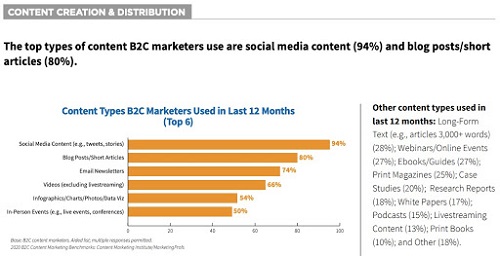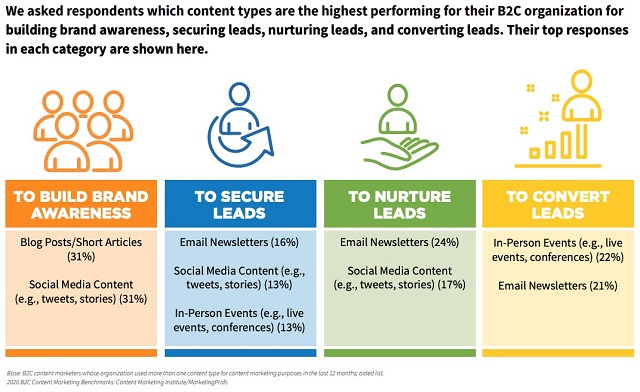Many business owners, entrepreneurs, and even veteran marketers devise their strategy for the New Year starting in January. I’m here to make a case for developing your 2021 marketing strategy now, or more specifically, throughout the last quarter of the year.
7 steps to develop your 2021 marketing strategy
Developing your 2021 marketing strategy doesn’t have to be done at once. Check out these seven steps to follow.
- Assess your 2020 goals.
- Confirm your marketing and business objective alignment.
- Redefine your audience (or not).
- Find the best performing content.
- Repurpose and update existing content and campaigns.
- Determine what new channels and tactics to test.
- Ensure authenticity in your messaging.
When Q3 ends, we’re typically focused on holiday campaigns, hitting year-end goals, maybe wrapping up financials for taxes, not to mention our personal obligations. Planning 2021 marketing might be low on the list. However, it’s the perfect time to start strategizing by looking back through past performance.
Reflecting on your previous year is far more helpful when it’s still fresh in your mind, without the distraction of the holiday rush, or after the first of the year when you still have vacation brain. Additionally, if you start your planning early, you’re not only avoiding procrastination but giving yourself time to thoroughly assess your previous goals, performance, and ROI of the past year to build the foundation for a successful new strategy for the year ahead.
Need a little motivation to start your planning? A recent report by CoSchedule found:
- Marketers with a documented strategy are 313% more likely to report success.
- Marketers who proactively plan projects and campaigns are 356% more likely to report success.
- Marketers who set goals are 376% more likely to report success.
Use the following steps to jump into planning your 2021 marketing strategy.
1. Assess your 2020 goals

Your first step should be to revisit your initial 2020 marketing strategy compared to your goals and overall performance. While the year isn’t quite over, you can determine how effective you were in the first three quarters. Take note of your key performance indicators (KPIs), objectives (you’ll want to keep those in mind to determine ultimate ROI), and overall efforts.
Granted, 2020 has been a roller coaster of a year. While assessing your success, give yourself some grace given how much we all needed to pivot and adapt due to the unprecedented nature of a global pandemic.
Your intention should be to gain a high-level view of your marketing success. If your goal was to increase sales by 10%, did you? If you wanted to double your follower count on social media, where do you stand?
Bottom line—were your 2020 goals realistic? If so, how can you further build on that success in 2021? If not, you need to figure out why through further evaluation and adjust your 2021 plans accordingly.
Your previous year’s goals will help you define your new objectives and guide your strategy to reach them. The next steps will help you build the specific tactics of your marketing plan while also analyzing past performance.
2. Confirm your marketing and business objective alignment
Too often, entrepreneurs or business leaders prioritize marketing just to check it off the list, and they aren’t sure why. They think, “every business is supposed to have a social media presence, right?”
The truth is that every part of your marketing effort needs to support your overall business goals. Whenever you spend time and resources on marketing, it should move the needle in some way. Looking back at the previous year, with your goals already in mind, ensure you have that alignment.
Part of this step of planning should be to develop critical pillars of your 2021 marketing strategy, I.E., what do you need to do next year to achieve those goals? Can you cross something off the list that didn’t work in 2020? Common marketing pillars include:
- Social media management and engagement
- Content production
- Keyword research for on-site SEO
- Paid advertising, PPC and paid social ads with accompanying landing pages
- Email marketing
To get an idea of what other businesses and marketers are doing, take a look at CMI’s Content Marketing 2020 B2C Benchmarks, Budgets, and Trends report. The top types of content created are social media, blog posts and email newsletters.

Make a list of your marketing pillars. As you move through the next steps, gauge success and confirm if you need to continue or pivot to a new tactic.
3. Redefine your audience (or not)
Who engages with your posts? Who opens your newsletters? Who finds your blog posts organically and reads the entire thing? The answer: your target audience. You may think you completely understand your ideal customer or client, but in reality, that’s always evolving. As consumer taste and preference change, so will your audience. Alternatively, there may be a different demographic that would benefit from your business and you had no idea.
The good news is that you can find data that tells you exactly who’s been interacting with your marketing this past year. This can help you redefine, update, and add to your target personas for 2021. To find demographic information, head to:
- Social media: Insights section of social platforms, typically under audience or followers.
- Website analytics: Dive into your site data to find visitor demographics. Accessing your dashboard is CMS- or platform-dependent. Check out directions on that for either Google Analytics or Squarespace.
- Email marketing platform: Most email marketing providers include analytics on your subscribers, as well as information specific to each campaign.
- Third-party platforms: If you use any additional marketing software or platforms, check for analytics there as well, you might gather additional insights into your audience.
When you understand the exact type of people already interacting with your brand, you can use that to guide your 2021 marketing strategy to make sure you’re creating customer-focused content and addressing the needs and interests of your audience. According to that same CMI report, more than half of B2C marketers (54%) create content for four or more audiences.
You might also find that your current targeting is still accurate, which is still great news because you can rest assured that next year’s marketing will continue to hit the mark.
4. Find the best performing content
While you’re looking back, review your social media posts and website content to discover your shining stars, i.e., best performing or most popular content.
As far as social, don’t feel overwhelmed like you need to survey an entire year’s worth of posts. Take it month-by-month and find the top-performing posts. Fortunately, most social networks allow you to find those easily by looking at previous months’ metrics.
For example, to view posts on Twitter for each month, just go to analytics, select Tweets, and sort by top Tweet. For Facebook, you can do the same by heading over to the insights page and choosing any of the metrics (Likes, Reach, Actions on Page, etc) then sorting by date. You just need to scroll through to find the best ones.
When it comes to content on your site, dive into your analytics, and assess which blog posts garner the most organic traffic (or use your specific KPIs).
Again, take note of CMI’s results as far as what types of marketing worked best to achieve specific goals:

The purpose of this exercise isn’t to be exhaustive but rather to get a high-level view of the types of content that performed the best throughout the year.
For instance, if you noticed that each month, product videos got the best engagement from followers, then you can create more in 2021. Perhaps the gift guides on your blog see the most organic traffic. Add similar topics and themes to your content calendar for next year.
Related: How to make data-driven decisions using Google marketing tools
5. Repurpose and update existing content and campaigns
Creating content, whether it be graphics for social media, writing blog posts, developing copy for ads or landing pages, even coming up with product descriptions — it’s all time-consuming. You don’t want to let that valuable content go to waste by simply publishing or sharing it once and forgetting about it.
When you look back at your past year’s marketing while also assessing that content’s effectiveness, you can take note of what content to reuse, repurpose, or update. If a social post performed well in February, there’s no reason you couldn’t tweak the caption and use the graphic again.
Make a list of your favorite, high-performing content to repurpose in your 2021 marketing strategy.
Updating content can be especially powerful when it comes to SEO performance on your site. A Hubspot case study found that updating old content doubled monthly leads generated and increased organic search views by 106%. Moreover, you’re getting more value out of work already done. Refer to Neil Patel’s guide for a deep-dive into content updating.
6. Determine what new channels and tactics to test
When you get a zoomed-out view of your year’s marketing it’s easy to see where you missed out. Perhaps you haven’t jumped in on TikTok or your video content is lacking.
Here’s where you might need to include a little competitor research as well. Take a look at similar businesses in your industry, assess their digital presence, and ask:
- Where are they spending their time on social media?
- What type of content is on their website?
- What promotions or campaigns have they run?
The most essential part of competitive research is to notice success and engagement. A competitor’s audience is yours as well, so make sure to see what their followers engaged with, check for comments on blog posts, etc.
7. Ensure authenticity in your messaging
The past year has no doubt kept everyone on their toes. However, one thing you can’t afford to miss in your marketing is authenticity—in both your messaging and connection to your audience.
Modern consumers, buyers, or clients want authenticity — 90% agree that it impacts what brands they like and support, according to Stackla. Another Sprout Social reportfound that more than half of consumers (57%) will increase spending with a brand they feel connected to and 76% will buy from them over a competitor.

Your supporters want to hear what you have to say, they want to know why your product or service will solve their problems, they want to see the face behind the screen.
The people who support your business want to hear what you have to say, they want to know why your product or service will solve their problems, they want to see the face behind the screen. That same Sprout Social report found that 70% of consumers feel more connected to a brand when their CEO or employees are active/visible on social media.
Have you been authentic in 2020? How can you be more transparent and real?
Related: How to create a social media strategy for the new normal
Feel confident in your decisions for your 2021 marketing strategy
When you determine the success, effectiveness and ROI of your efforts, it’s much easier to allocate resources and budget for the following year. Too often, managers or business owners (especially SMBs and solopreneurs) say they’ll audit their marketing from the previous year or analyze performance. Then it falls further and further down the to-do list.
When you take the time to truly assess your past strategy — data, metrics, KPIs, what moved the needle, the results from when you pivoted during a global pandemic — you’ll feel much more confident in investing in your future growth. Whether that be by outsourcing marketing tasks, allocating more time and budget towards successful channels, or trying new tactics.
Find your marketing purpose for 2021
Your 2021 marketing strategy only has to be as complex or in-depth as your specific business needs. Don’t be overwhelmed by developing your annual plan; it can be as simple as determining your monthly PPC budget and how many social/blog posts you plan to publish. Alternatively, it can also be a cohesive plan for your marketing team that guides your efforts while aligning all platforms and messaging — it’s totally business-dependent.
The most important factor is to actually have a plan in place.
When you’re looking back to develop your 2021 marketing strategy, it’s time to figure out what worked and what didn’t, to serve as the foundation for future roadmap. Trust me, it will be a much easier and more valuable exercise if you get started ASAP!
The post Develop your 2021 marketing strategy — looking back to plan ahead appeared first on GoDaddy Blog.

Recent Comments